Guayupe people
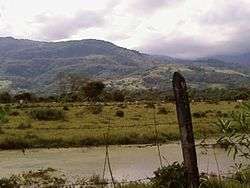 Landscape in Acacías, terrain of the Guayupe | |
| Total population | |
|---|---|
| 250,000[1] (1537) | |
| Regions with significant populations | |
|
Meta, | |
| Languages | |
| Arawakan, Colombian Spanish | |
| Religion | |
| Traditional religion, Catholicism | |
| Related ethnic groups | |
| Guahibo, Muisca, Sutagao, Tegua, U'wa |
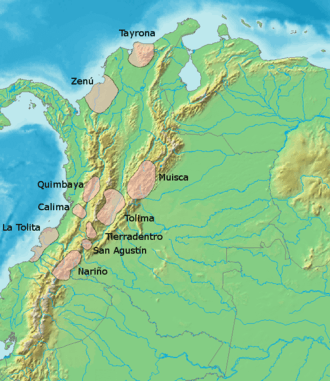
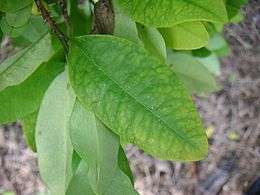
The Guayupe are an Arawak-speaking[2] indigenous group of people in modern-day Colombia. They inhabit the westernmost parts of the department of Meta.[3] At the time of the Spanish conquest, more than 250,000 Guayupe were living in large parts of Meta.[1][4]
The territories of the Guayupe stretched from the neighbouring Guahibo terrains to the east and north and the Muisca territories to the east over an area of 22,000 square kilometres (8,500 sq mi).[5]
Knowledge of the Guayupe has been provided by Pedro de Aguado and others.
Guayupe territory
The territory of the Guayupe before the Spanish conquest stretched from the rivers Upía and Guayabero to the peaks of the Eastern Ranges of the Colombian Andes.[6] Their area covered around 22,000 square kilometres (8,500 sq mi).[5] The Guayupe lived mostly around the Ariari River.[5]
Municipalities belonging to Guayupe territories
| Name | Department | Altitude (m) urban centre |
Map |
|---|---|---|---|
| Acacías | Meta | 498 |  |
| Barranca de Upía | Meta | 200 | 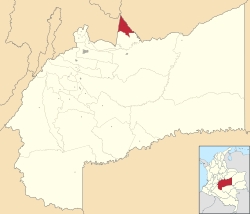 |
| El Calvario | Meta | 1987 |  |
| Cubarral | Meta | 534 | 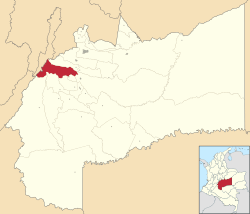 |
| Cumaral | Meta | 452 |  |
| Fuente de Oro | Meta | 359 | 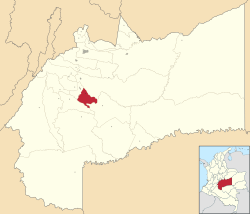 |
| Granada | Meta | 372 | 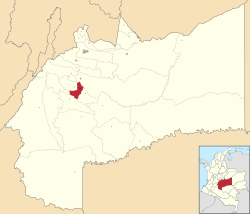 |
| Guamal | Meta | 525 | 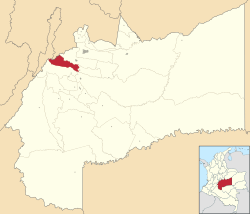 |
| Restrepo | Meta | 570 | 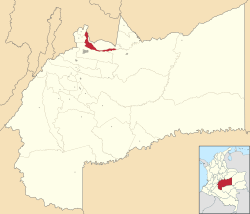 |
| San Juan de Arama | Meta | 510 | 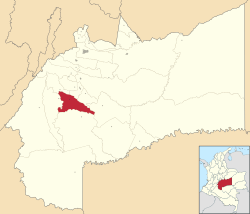 |
| San Juanito | Meta | 1795 | 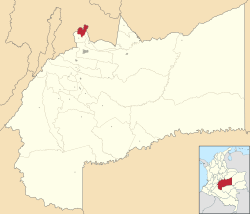 |
| Villavicencio | Meta | 467 | 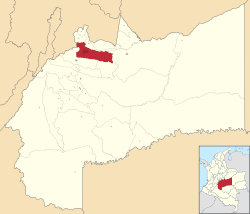 |
Description
The Guayupe are a tribe of farmers living in the tropical mountain forests of the Eastern Ranges and the Llanos of Meta, Colombia. In pre-Columbian times they constructed pallisades around their villages consisting of houses around a central square with a ceremonial building in the middle.[7] The Guayupe were an agricultural society with yuca one of their main crops.[7] The Guayupe people went naked, only ornamented with gold, feathers and shells.[7]
The Guayupe society was organised around the caciques; chiefs of the community. The cacique was regarded as an important person who lived by strict norms in the ceremonial activities; births, marriages and burials. When a cacique of the Guayupe died, the body was cremated and his successor had to drink his ash mixed with chicha.[7][8] The society of the Guayupe was egalitarian; caciques only had the use of stools and more feathers on their blankets. At every marriage, half of the bride treasure was going to the cacique.[7]
They built canoes of wood and consumed yuca and casabe, fish and meat. They didn't eat bird meat.[7][9]
According to scholar Pedro de Aguado, the Guayupe defecated in the rivers around and not near their houses.[10]
Religion
As in the Muisca religion, the main gods were the Sun and the Moon who were husband and wife.[7][11] The supreme being of the Guayupe, in the Muisca religion called Chiminigagua, was Inaynagui.[11]
The products the Guayupe used in their rituals were coca and tobacco.[7] Cannibalism is not reported of the Guayupe.[7]
Modern age
In 1996, fifteen ceramic pots were found, pertaining to the Guayupe culture.[12] In 2011, after the excavation of a Guayupe burial site, the museum of the Guayupe in Fuente de Oro was opened, containing bones, burial urns, artefacts and plates.[13] As of 2009 yearly a Reina de Guayupe, miss contest in Puerto Santander, located at 16 kilometres (9.9 mi) from the urban centre of Fuente de Oro,[8] is held among the Guayupe.[14][15]
See also
References
- 1 2 Ruíz Churión, 2010
- ↑ (Spanish) Description Guayupe
- ↑ Díaz Moreno, 2012, p.171
- ↑ Díaz Moreno, 2012, p.174
- 1 2 3 (Spanish) Description of the Guayupe
- ↑ (Spanish) 2007 - Más de 50 piezas arqueológicas de la desconocida cultura guayupe tendrán museo en el Meta - El Tiempo
- 1 2 3 4 5 6 7 8 9 Onofrio, 1995, p.438
- 1 2 (Spanish) 1999 - Guayupe museum - El Tiempo
- ↑ (Spanish) Cultura Guayupe
- ↑ Mácha & Gómez, 2014, p.67
- 1 2 (Spanish) The Guayupe of Granada, Meta
- ↑ (Spanish) 1996 - Fifteen Guayupe ceramic pots found in 1996 - El Tiempo
- ↑ (Spanish) Museo arqueológico Guayupe
- ↑ Díaz Moreno, 2012, p.182
- ↑ Díaz Moreno, 2012, p.187
Bibliography
- Díaz Moreno, Ingrid. 2012. Puerto Santander, cuna de la cultura guayupe: Patrimonialización y formación del Estado en el departemento del Meta - Puerto Santander, crib of the Guayupe culture: heritage and formation of the State in the Meta Department. Tabula Rasa 17. 171-193. Accessed 2016-07-08.
- Mácha, Přemysl, and José Eloy Gómez Pellón. 2014. Masks of Identity: Representing and Performing Otherness in Latin America, 1-185. Cambridge Scholars Publishing. Accessed 2016-07-08.
- Onofrio, Jan. 1995. Dictionary of Indian Tribes of the Americas, 1-1047. American Indian Publishers. Accessed 2016-07-08.
- Ruiz Churión, Jairo. 2010. Guayupes. Accessed 2016-07-08.
Further reading
- Moreno Romero, Marisol, and Ricardo Riaño Cardenas. 1998. La cultura guayupe: presencia prehispánica en los llanos del Meta - The Guayupe culture: prehispanic presence in the plains of Meta, 1-102. Alcaldía Mayor de Villavivencio. Accessed 2016-07-08.